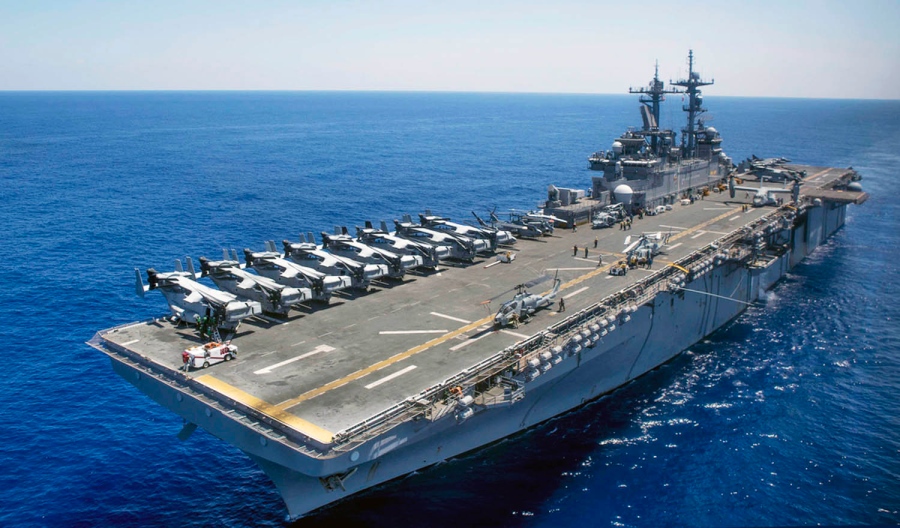The way Seventh Naval Fleet failed in the war 1971.The Seventh Naval Fleet is the largest naval force outside the mainland of the United States. It is a part of the United States Pacific Fleet. Its main base is currently in Yokosuka, Japan. America’s most advanced and powerful ships are in the Seventh Naval Fleet. With 60 to 70 warships, 200-300 warplanes, and about 40,000 navies, it is the most powerful navy in America.
In December 1971, US President Nixon decided to use direct military force on behalf of Pakistan, knowing that Pakistan would be defeated by the Liberation Army and its allies. At that time, due to the Vietnam War, most of the ships of the Seventh Fleet were close to Vietnam, so on December 9, President Nixon ordered the Seventh Fleet to sail to the Bay of Bengal. But Nixon’s plan failed because of the warnings and countermeasures of Russia and India.
Taskforce 74 was formed on December 10, 1971, with several ships from the Seventh Fleet, on the instructions of President Nixon. The ships assembled in Singapore and set sail for the Bay of Bengal. All the ships in the Seventh Fleet were-
1. USS Enterprise: The main ship in the fleet is the USS Enterprise. This USS Enterprise was then the largest aircraft carrier in the world. By far it is the largest warship in the world. It was carrying 75 fighter jets, most of them F-Four Phantom Fighters. The enterprise was also carrying nuclear bombs when it reached the Bay of Bengal. It was the main warship of Task Force-74.
2. USS Tripoli: This is an amphibious assault ship. It had a battalion of 2,000 Marines and 25 assault helicopters. 3. USS King: Guided Missile Destroyer. 4. USS Decatur: Guided Missile Destroyer. 5. USS Persons: Guided missile destroyers. . USS Boussell (DD-845): Gun Destroyer. . USS Ordak (DD-886): Gun Destroyer. . USS McCain (DD-784): Gun Destroyer. 9. USS Anderson: Song Destroyer. 10. USS Haliyekala (AE-25): Military cargo ship and a nuclear-attack submarine.
On 10 December the Seventh Fleet took up position on the Strait of Malacca. Henry Kissinger, an adviser to US President Nixon, warned Russia’s Washington envoy on December 1 that “India must be forced to accept a ceasefire tomorrow.” Otherwise, the United States itself will take the necessary military action.
The ships crossed the Strait of Malacca on 14 December and entered the Bay of Bengal on 15 December. The US government has announced that Task Force 74 has been sent to assist Pakistani troops return to Pakistan. But due to the tough position of Russia and India, this navy did not dare to take position in the Bay of Bengal. During this time the Indian Navy placed its aircraft carrier INS Vikrant in the Bay of Bengal with a naval blockade. After “Task Force 74” left for the Bay of Bengal, all the ships in Chittagong port were destroyed in one day.
The Soviet Union had already feared that the Seventh Fleet would arrive in the Bay of Bengal. So in advance they deployed a mine sweeper ship, a destroyer, a battle tank carrier ship and a submarine on a goodwill visit to the Indian Ocean. Another mine sweeper and a destroyer took up position in the Indian Ocean. The Soviet government ordered all six ships to stay close to the Bay of Bengal. A nuclear cruise missile, a battle cruiser and a nuclear submarine set sail from Russia for the Bay of Bengal.
After the Seventh Fleet’s official voyage to the Bay of Bengal on 10 December, the Soviet government announced on 13 December that it was sending another anti-carrier task force with the previous ships to intercept the Seventh Fleet, including a nuclear cruise missile with a nuclear bomb-carrying missile, a nuclear missile, a nuclear missile. Submarine and a destroyer.
On December 15, the Soviet Union deployed warships against the Seventh Fleet. On this day, 20 Soviet warships took up position in the Indian Ocean. The Seventh Fleet then refrained from taking part in the war and the United States was forced to withdraw the Seventh Fleet.
After Bangladesh’s full independence through the surrender of Pakistani forces on 16 December, America’s position on the battlefield became isolated. At that time, if the war broke out, there was no chance for Pakistan to join. There were about 20 Soviet ships nearby. Rumors have been circulating since the beginning that a Soviet nuclear attack is coming from behind the submarine enterprise.
On December 16, Task Force 74 was taken from the Bay of Bengal to the Indian Ocean. The fleet remained there until January 1972. After January 7, Task Force 74 was sent back to the Vietnam War.
History of the Seventh Fleet
During World War II, the Seventh Fleet was formed on 15 March 1943 in Brisbane, Australia under Admiral Arthur S. “Chips” Carpenter. It was deployed in the Southwest Pacific (SWPA) under Douglas MacArthur. The Seventh Fleet Commander also served as Commander of the Joint Naval Forces in the Southwest Pacific (SWPA).
Most of the ships of the Royal Australian Navy were under Task Force 74 (formerly Anzac Squadron) from 1943 to 1945. Battle of Leyte Gulf; During the largest naval war in history, the Seventh Fleet was a large part of the combined naval force under Admiral Thomas C. Kincaid.
At the end of the war, the Seventh Fleet relocated its headquarters to Qingdao, China. Under Operation Plan 13-45, Kincaid formed five major task forces on 24 August 1945 to conduct operations in the western Pacific.
“Task Force 71” includes 75 ships in northern China, “Task Force 72” provides air cover to the Marine Force as the fastest carrier force and obstructs the operations of the communist forces, “Task Force 73” consists of 75 ships Yangtze Fatal 4. “South Chinese Area Force” was formed to prevent the movement of Japanese and Chinese troops and “Task Force 6” as an amphibious force was formed to prevent the movement of Chinese naval amphibious corps (III Marine Amphibious Corps).
At the end of the war, on 1 January 1948, the navy was renamed the Western Pacific Navy. The navy later moved its main operational base to the Philippines, where the Navy developed its naval facilities at Subic Bay and removed their airfield at Stagley Point.
Admiral Arthur E. Redford, commander of the Pacific Fleet, provided operational command of the peace fleet, but operations under the Naval Force Far East were conducted under General Douglas MacArthur at the Japanese border or in any other emergency operation.
On August 19, 1949, the Navy was renamed the United States Seventh Task Fleet. It was named the Seventh Fleet of the United States before the Korean War on February 11, 1950. Which is still known as the Seventh Fleet.
Seventh Fleet in which wars took place –
Korean War:
A regional military war between South Korea and North Korea that lasted more than three years (June 25, 1950 – July 26, 1953) is known in history as the Korean War. The Soviet Union and the People’s Republic of China, on behalf of North Korea, and the United States and several other countries, with the consent of the United Nations on behalf of South Korea, took part in the war directly.
Although the Korean War ended in 1953, no formal agreement was reached. The war ended with a ceasefire agreement signed between the United States and the North Korean military and China on behalf of UN forces. It is estimated that two and a half to three million people were killed in the war.
Seventh Fleet units participated in major operations in the Korean War. The first naval jet used in the war was launched on July 3, 1950 by the Task Force 8 (TF77) aircraft carrier. The first operation to land in Incheon, Korea, was conducted from the Seventh Fleet’s amphibious ship.
The warships Lua, New Jersey, Mausuri and Wisconching fought under the Seventh Fleet during the Korean War. During the war, Air Wing One and Air Wing Six fought under Task Force 70 as Maritum Patrol Force, Task Force 72 as Formza Pranali Patrol Unit, Task Force 8 and Task Force 69 as Auxiliary Squadron under the Seventh Fleet.
Vietnam War
The Vietnam War is considered to be the most horrific war for genocide in the history of the world. This war still moves, thrills and inspires people to unite on the path to peace. America is considered to be the most powerful and superpower in the world. This America was defeated in the Vietnam War.
The war, which lasted almost two decades, claimed the lives of 3 million people in Vietnam. The war killed 58,000 US troops. This is the first time in the world that a modern superpower has lost so many lives to its troops. The Vietnam War is also an example of a superpower being defeated by the United States.
The Seventh Fleet was used during the Vietnam War. In particular, the navy conducted air strikes inside Vietnam. About 12,000 helicopters are used in Vietnam’s mountainous jungles to supply troops, supply troops, and strike specific locations. However, about 5,000 helicopters were destroyed by Vietnamese guerrillas. Notable helicopters inside were the Hugh: Bell UH-1 Iroquois, Bell AH-1 Cobra, Boeing CH-47C-Knight, Boeing CH-47 Shinuk, Sikorsky CH-34 Choctaw, Sikorsky HC-SKY3, -53 Sea-Stallion.
On February 12, 1965, an American submarine named Salisbury Sound began operations inside Vietnam and began participating in the Seventh Fleet. Arbitration works to provide naval support for bombing North Vietnamese troops called Operation Flamingo Dart.
Task Force 61, Task Force 65, Task Force 8, Task Force 8, Task Force 8, Task Force 116 and 116 took part in the Vietnam War. At the end of the war, in 1975, the Seventh Fleet took part in the Refugee Evacuate in South Vietnam.
Gulf War:
The Gulf War began on August 2, 1990. It officially ended on February 26, 1991. The war, popularly known as Operation Desert Storm, took place between Iraq and a UN-sanctioned joint force of 34 countries. The war began on August 2, 1990, with the Iraqi army occupying Kuwait. The purpose of the war was to liberate Kuwait from Iraqi forces in the wake of the Iraqi invasion of Kuwait in August 1990 and the occupation of Kuwaiti territory. US President George HW Bush W. Bush deployed troops to Saudi Arabia and called on other nations to send troops.
In August 1990, US President George HW Bush appointed the Seventh Fleet in response to the Iraqi invasion of Kuwait. The fleet commander immediately set sail for the Persian Gulf from Yangsoka, Japan. The American Central Naval Command participated after World War II under Operation Desert Storm and Operation Desert Shield. About 130 U.S. warships and about 50 joint force warships participated in the Gulf War. Ships participate in mine clearance, maritime operations and wartime operations.
Naval Central Command deploys six aircraft carriers, two battleships, two naval hospital ships, 31 amphibious assault ships, four mine-clearing vessels and several more warships to assist the Joint Forces Air and Ground Forces. After the Gulf War, the Seventh Fleet returned to its designated location.



